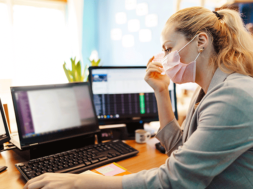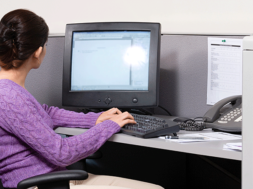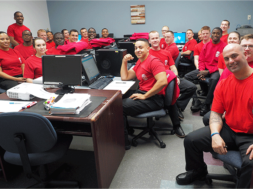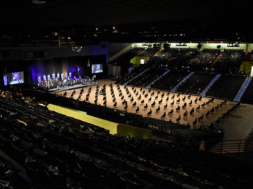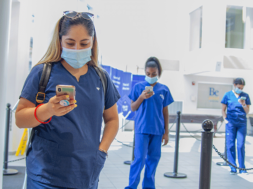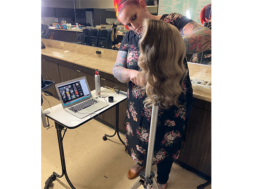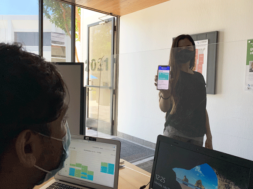
Schools Share Their Strategies, Plans to Reopen After Pandemic
Written from interviews with career education leaders
In mid-March, the world as we know it came to a halt. With news that a new novel coronavirus had spread to the United States, non-essential businesses, government offices and public and private schools and universities were forced to close to stop the spread of the disease that has since infected more than 1.8 million and killed more than 108,000 people nationwide.
Now in June, as businesses start to reopen in the U.S., career college officials throughout the country agree that school reopenings must be deliberate and carefully planned.
Career Education Review talked to school leaders with various programs and facilities scattered throughout the nation to gain their perspectives on the reopening process and to share their suggestions on how to keep faculty, staff, students and others safe as schools move to again start on-campus instruction.
Centura College, Aviation Institute of Maintenance and Tidewater Tech
Joel English, chief operator and executive vice president of Centura College, Aviation Institute of Maintenance and Tidewater Tech, said they successfully moved their classes online when the first governors’ orders took effect in the states they serve.
“We knew we had to react, and our reaction was to quickly create a teach-out method for the current term,” he said. With two weeks left before spring break, they taught online or gave students work to take home, thus allowing them to successfully finish the term.
Next, they started preparing for their following term to be held completely online. They trained faculty, staff and students on GoToMeeting and Microsoft Teams, and by April 6, they had started all of their 19 schools online.
With hands-on, skilled trade programs, administrators decided to prepare for only a five-week term. In short, they did lectures online and postponed the hands-on shop portion until they could get students back to their respective campuses.
Within about a month, they were able to create a social distancing plan, splitting students into groups of 10 or less. By May 11, most of their campuses were able to have small groups of students in classes.
“Right now if you stepped into any one of my campuses, you would see students in small groups that are doing the hands-on activities associated with what they’re learning online,” English said. By June 15, they hope to have something that looks a little closer to normal, where all students will have some instruction face to face and some online.
“Ultimately, when we get out of this whole thing, we do think online education is here to stay,” he said. “My faculty is ready, my students are interested and we would like to have this.”
In fact, they had no students who said online is not what they signed up for. “Our drop rate has been lower than normal during this time,” English said. “We usually would see a drop rate of about 2% in any given month. In April, we saw a 1% drop rate.”
A five-member coronavirus taskforce, created in March, came up with guidelines on how to safely reopen the schools.
“We meet every week and talk about everything, from governor’s orders and when they’re expiring, to the various things that we’ve done for our faculty and staff,” English said. “On the HR policy side, we’ve done some things for staff that are unique for us. For example, we created an extra two weeks of sick leave for anybody who tests positive for the coronavirus.”
Now, as they prepare to bring students back to school, they use recommendations from the Centers for Disease Control and Prevention as their Bible in what they will and won’t do, he said.
“The first thing we did is create a set of posters that have all the CDC guidelines on them,” he said. They also purchased no-touch thermometers for their campuses and home office.
“We take student and staff temperatures every day upon coming to work,” he said. “As per CDC guidelines, if somebody has (a temperature of) over 100.4, they’re asked to go home for the day and not come back until they’ve been fever free for 24 hours.”
They’ve also moved desks, chairs and training equipment so that students, faculty and staff can be 6 feet apart. In addition, they encourage the use of face masks, just as the CDC recommends their use, rather than requiring their use.
For students who don’t yet feel comfortable returning to campus, English said they are continuing to offer online courses through June, and are considering extending that into August.
“Any student who doesn’t feel comfortable doesn’t have to come back yet,” he said. “But the longer they decide to wait, the more they have to make up the hands-on shop work.”
English said their current policy for faculty and staff allows them to work from home one day a week, essentially producing about 20% less foot traffic in their buildings. They also created a staggered shift situation where one-third of the staff comes in at 8:15 a.m., one-third comes in at 8:30 and the rest arrive at 9 a.m.
But as the executive orders expire by the end of June, faculty and staff will be back to working five days a week in their offices, English said, adding that it’s difficult to tell some employees they can do their jobs from home and others can’t.
“Ultimately, the decision I made is (that) we are an organization centered on serving students. Whether we’re serving them through instruction, serving them through financial aid administration, serving them through admission work, serving them through the registrar/bursar office – all of the roles are centered around one place where the students come. I don’t anticipate us doing work from home in the future. We’re going to get back to work as things expire.”
English said they saw student inquiries increase during the pandemic, likely because more people were looking for work or looking for what happens next in life. While they didn’t change their marketing, they did change the way they fielded those inquiries, offering more online tours, primarily through FaceTime.
They have not had any issues regarding accreditation or state regulations, but they have very much stayed in touch with those agencies.
“We had to apply and refresh our online plan, as per their guidance,” he said. “With the AIM campuses, the biggest thing is the FAA. Almost every instructional method, assignment, project and tool that we have must be approved by the FAA. That can be a challenge to get the FAA primary maintenance inspector to agree and approve what we do. But even there, with 13 aviation campuses, 13 different FAA offices to please, they were very much in favor of the way that we delivered online content and approved it in every case.”
If there is a silver lining to the pandemic, it’s that schools have become better at technology such as videoconferencing and are more open to online learning, English said. But they also became more sensitive, particularly to responding to situations around individual schools. He said school leaders communicated more, and thus allowed schools to be flexible, morph and change depending on the situation.
Centura College, the Aviation Institute of Maintenance and Tidewater Tech have 19 schools throughout the country. But the Aviation Institute of Maintenance, or AIM, provides the broadest coverage with its 13 schools located from San Francisco to Atlanta. AIM has about 4,000 students in its aviation maintenance technician program that prepares them for the Federal Aviation Administration (FAA) certification as an aircraft mechanic. Centura College and Tidewater Tech schools are in Virginia only and educate students in skilled trades such as welding, heating, ventilation and air conditioning or HVAC, automotive technician, construction electrician and carpentry. Tidewater Tech, in Norfolk, Virginia, is the largest welding school in the southeast Virginia area.
Charter Colleges
When the pandemic hit, Josh Swayne, CEO and president of Charter Colleges, said having businesses in seven states meant they had to manage state by state, governor order by governor order. Charter is managing the schools’ reopenings on the local level.
“In Alaska and Montana, we are at a point that we can bring back students to (do) just the lab components,” he said, adding they are bringing back students in dental and health care programs to allow them to finish the clinical side of courses they were unable to complete during the stay at home. They have also chosen to keep whatever they can online.
“Like many, we did bring on some simulation to supplement some of the education,” Swayne said.
“That worked for a little bit for the hours needed and from an instructional standpoint. But the bottom line … is that (students) need the hands-on. If you’re going to give a shot, you’ve got to give a shot in the arm and you can’t just do a simulation of that.”
As they bring students back to campus, Charter is doing exactly what the state or the health department requires, and nothing more or less, Swayne said. They are also documenting their efforts.
“When we stepped into the planning stage, we wanted to ensure the complete safety of our students and our staff, but (we) didn’t want to get overanxious to create our own little ‘let’s do this as an added precaution,’” he said.
They did create an animated training video that was distributed to students and staff. It shows people what things will look like when they return to campus with gloves, masks, social distancing and more. In addition, their website clearly defines what the college is doing to stop the spread of COVID-19, creating one place students and staff can go to for information. The animated video is included on the website.
“It’s like the CDC guidelines; if you’re feeling these symptoms, don’t come in,” Swayne said. “It’s nothing that you can’t see somewhere else. We’ve just tried to customize that to Charter College or Charter College Montana campuses so they can see what’s now being required of them, whether that’s gloves, masks, (getting their) temperature (taken) and those types of things.”
Most of their staff are still working remotely, he said, noting that as an essential business, they stayed open throughout the stay at home orders.
Swayne said they’ll wait for more guidance from the “local folks” before they open up further. “We’ve been somewhat on the reserved side,” he said. “Washington opened up and we took about a week and a half to get our plan together and to get people educated, so it wasn’t just a mad rush back onto the campus. We’re trying to be very cautious…”
Swayne said he expects to see a growing need for mental health services for students and staff who are experiencing anxiety or other health issues, or even trouble securing child care. As a company, they are seeking out professionals who can help.
“Whether it’s a staff member or student who needs professional help, we’ve got resources and books in place and we’ve added to that element,” Swayne said. In most states, June 22 is the date that business can go back to “normal,” or full capacity, and he said Charter Colleges is working toward having everyone come back to campus.
Students who don’t want to come back by June 22 can take a COVID-19 incomplete or COVID-19 leave of absence, although only two or three students so far have done so. “Most of those are dealing with some kind of health concerns,” he said. “They’re not being penalized by not coming back because of the disruption that COVID-19 has created.”
Swayne said they are more concerned about safety issues than they are about liability, as long as they continue to apply all the state and health department recommendations.
Their marketing strategies for enrolling new students hasn’t changed, although their messaging has. “When people call, we’re definitely talking about things we didn’t talk about (before) in terms of what does online mean. If I do come in, what are the safety procedures? How do you operate? Those kinds of conversations are taking place.”
They do use a wide variety of measures to enroll new students, although due to internet bandwidth issues, most students just want to see pictures of the labs or the school, rather than a complete virtual visit.
Charter College has also applied for Higher Education Emergency Relief Funds, or HEERF, and they’ve only pulled down that which they’ve been certified to distribute to students.
“We’ve followed the policies and procedures and began to communicate that out to the students about the grant money that’s available to them based on the disruption … to their education,” he said.
The biggest challenge to overcome with COVID-19 has been the unknown and the attitude of people. Managing a school during a pandemic has been difficult, and Swayne said he tried to focus on what they could control and how they will move forward and create that new normal.
He said it’s clear that career education will change post-pandemic, although vocational technical skills won’t go away. But there will likely be more acceptance of simulation and online, and more schools will probably use a hybrid component, Swayne predicted.
“We’ll quickly adapt to what business does,” he said. “The mindset of how one can learn has been adjusted more toward virtual learning. But it’s never going to replace the complete human interaction that’s needed in the type of trade skills that we deliver.”
And some good did come out of the pandemic, such as their staff coming together and solving the problems caused by COVID-19. “The silver lining is just the camaraderie, the relationships (and the) best practices as it relates to communicating within our organization and trying to get a group to move together in one cohesive direction,” Swayne said. “We’ve had more interaction and communication among some departments and developed better methodologies to do so than we once had.”
Charter College operates 14 different colleges in five states – Alaska, Washington, Montana, New Mexico and California – and has an online division. They also have an office in Reno, Nevada and a service office in Salt Lake City, Utah. Charter is nationally accredited and offers training in health care, business, veterinary sciences, information technology and the trades.
Lincoln Educational Services
Scott Shaw, president and CEO of Lincoln Educational Services, said they announced on March 17 they were closing all their campuses and moving everything online. Despite needing some regulatory approvals and other signoffs since they are located in different states, they were able to move all programs online in about 10 days.
They worked with states and accreditors to institute simulations and other things to help replace some of the externships or clinical sites that are required for certain careers, especially in the health care area, Shaw said. But when students came to a point in their education that they had to be doing something hands-on and they were unable to do that, Lincoln suspended their education until they could bring them back on campus or send them to a clinal site.
By press deadline, Lincoln had opened four of its campuses – one each in Dallas, Nashville, Indianapolis and Denver. And in New Jersey, where they have six campuses, they are hearing more doctors’ offices are opening up and asking for students to come in for the clinical portion of their education.
“Things are slowly getting back to normal,” Shaw said, “but it’s going to be a long time before we’re fully back to normal.”
Shaw said a committee tracks and follows the local and national rules and regulations about reopening, and they follow that guidance. Students and staff arrive in smaller groups and staggered times on campus, and get their temperature taken daily, as well as fill out forms about if they feel healthy. In addition, they sterilize facilities daily. Students must also practice social distancing, and the schools encourage them to wash their hands often.
If students don’t want to come back for personal reasons, they’ll suspend their education until they’re more comfortable. “But we are still offering everybody online training,” he said. “We’re just opening up the schools at this time to allow students to come back to do some hands-on work.”
Faculty and staff who feel uncomfortable returning to work will be reassigned to do online training or student support work. However, they are asking certain people in each department to come back to campus, just to help support those students who want to see a person face to face. But social distancing is a must for those on campus, and the rules are clearly stated on posters throughout their facilities.
In most places, it’s a 9-1 ratio in a class, he said, adding that there is at least 6 feet between people.
Everyone is also required to wear masks. “That’s become one of the more challenging things as we reopen schools to make sure that people keep their masks on,” Shaw said. “Frankly, (masks) can be quite annoying, especially if you’re a faculty member with it on for eight hours. You need to … give people breaks … where they can be in a place where they don’t have to have their masks on.”
For students or staff experiencing stress or other mental health issues because of the times, they offer tele-counseling. Students and staff have said they enjoy working from home because they don’t have to juggle child care and it saves them stress, time and money.
That’s one of the reasons Shaw predicts online courses will be a permanent addition for their schools. “It just builds in a lot more flexibility for people.”
They’ve been trying to structure a typical class day so people know that at 8:30 they must sign on and the instructor will be there to start class. “So it’s all live as if you’re (physically) in the class,” he said.
Shaw said they have had some issues regarding accrediting or state regulatory bodies or licensures because they operate in different states.
“For example, the Board of Nursing in Connecticut seems to be not as receptive to simulations compared to other states that seem to have adopted that as a strategy,” Shaw said. “They’ve adopted it in Connecticut, but on a much more limited use.”
Possible liability is a big unknown, but Shaw said they follow all the recommended guidelines to ensure they’re keeping people safe at all times.
While their marketing strategy hasn’t changed for enrolling new students, their messaging has.
“The reality is we’ve always been a career education company. We’ve always thought that the careers that we train for are very important and meaningful,” he said. “Now … we’re being classified as essential, critical infrastructure workers. People are realizing that if my car’s not running, or the Amazon truck is not running to deliver our products … everything starts breaking down in our society.
“If you’re at home and your electricity goes out, or your air conditioning is not working, your quality of life is dramatically impacted,” Shaw said. “So … everything that we’re training for, such as our LPNs or our medical assistants, are all programs that are classified by Homeland Security as critical infrastructure workers.”
Shaw said it’s about time these essential works get the respect for what they do. “From a marketing standpoint, we’re just trying to really highlight what important jobs these are and … that these are individuals who are on the frontlines.”
Unlike some of the other educators, Shaw sees career education changing because of the pandemic.
“It has to change,” he said. “We have to figure out ways to make it as affordable and accessible as possible. I think the attention that career education is getting now is going to help drive even more demand.”
Shaw sees the nation’s high unemployment driving interest in career education schools because people realize they can have a solid career by learning one of these valuable skills that are in high demand.
“I think it’s going to be some of the better times for career education and it’s going to get the respect it always should’ve had,” Shaw said. “I think that the way that we deliver it is going to get better and more engaging. I just see things getting better…”
Lincoln Educational Services has more than 11,000 students in its 22 campuses in 14 states under three brands: Lincoln Technical Institute, Lincoln College of Technology and Euphoria Institute of Beauty Arts and Sciences. Lincoln was created about 75 years ago and focuses on three main areas: automotive transportation; skilled trades such as welding, HVAC and electrical; and health care, such as medical assisting and licensed practical nursing.
Minnesota School of Cosmetology
The Minnesota School of Cosmetology closed its two campuses on March 17 to stop the spread of the coronavirus, said Stephanie Hauer, campus director of their Plymouth school. They originally hoped to reopen on March 30, but more regulations relative to the stay at home order extended that reopening date. Students finally returned to campus June 1.
Distance learning really wasn’t an option since they needed to get so many approvals through their accreditor and the Minnesota Board of Cosmetology. Angie Norbeck, vice president of academic affairs and campus director at the Woodbury school, said their situation was unique as they have three programs at their two locations: cosmetology, esthiology and massage therapy.
“Cosmetology and esthiology are regulated by the Minnesota Board of Cosmetology,” she said noting that Minnesota is one of a few states without licensure requirements for massage therapy. “We went with the stricter guidance that came from the Board of Cosmetology just so that we could be consistent with all of our programs.” The Board of Cosmetology only allows for theory hours.
“Our programs are clock hours consisting of both theory and practical,” she said, “and practical hours are not to be performed outside of the school.”
To reopen, the school followed the guidelines in a plan put out by the Minnesota Office of Higher Education, Norbeck said. From that, they created a nine-page preparedness plan that addresses employees, students, visitors and clients.
“It addresses if somebody is exhibiting signs and how we work through that, hand-washing, respiratory etiquette, social distancing, communication, housekeeping, training and all of those various pieces,” she said, adding they also utilized resources from the CDC, the Minnesota Department of Health and the American Massage Therapy Association.
The week before opening, they brought staff in to go over the plan, including safety and sanitation, and ready the classrooms for proper social distancing. They put up posters around the schools to make sure everyone understood the new rules. Students then went through the safety and sanitation training on their first day back.
As of press deadline, Minnesota had not yet approved person-to-person contact for cosmetology schools, as well as their clients, Hauer said. So they didn’t take on clients when they opened, and are waiting to get a definite answer from the Board when the students can resume person-to-person contact.
While they won’t take students’ temperatures before entering the school, they will ask them about symptoms and do verbal or written checks with them daily, Hauer said. If students don’t feel well, they will be asked to leave for the day.
Since MSC doesn’t have a leave of absence policy, students not ready to come back are withdrawing from the school and will set a reentry date in the future, Norbeck said. “It’s just case by case with each student.”
Liability issues haven’t been a concern, Norbeck said, since they have followed CDC and Department of Health guidelines.
“Being in the cosmetology industry, there are a number of rules and regulations that were already in place in terms of maintaining safety precautions such as cleaning and disinfecting,” she said. “I feel really confident about the protocols we put in place because they align with what we’re seeing from other higher education institutions.”
If students refuse to follow the new safety guidelines, they will be sent home, Hauer said. “
We are going to (take) every preventative measure to make sure that we are as safe as we possibly can be and that everybody does understand how serious (this) is … There isn’t room for error. They will be sent home.
There will also be documentation saying they were sent home due to whatever policy or procedure that they did not follow.”
MSC has not changed its marketing during the pandemic, and has no plans to change it going forward. “Our enrollments are still very strong for all three programs,” Hauer said.
MSC did apply for HEERF funds and contacted students to let them know they were eligible for the funds, Hauer said. To receive funds, students had to verify who they were and choose whether to opt in or out. MSC then sent out two disbursements to students. “If they did opt out, (those funds) were able to go to another (student) who may be in more need,” she said.
MSC, too, has not had any issues with its accreditation during the pandemic, and Norbeck said their accreditor, the National Accrediting Commission of Career Arts & Sciences, or NACCAS, has been “super responsive.”
“I couldn’t be more pleased with how quickly they were able to get us the information we needed,” she said, adding that they set up webinars, gave regular school updates and more.
If there is one thing they’ve learned is that their employees are always compassionate. And that will be important as students head back to the classroom.
“We’ve talked a lot with our employees about having compassion and understanding since there’s a lot … going on, not just with COVID-19 right now … that could impact the students,” Norbeck said. “It’s getting them back into some sort of routine, but then still keeping that compassion.”
Norbeck said she’s unsure what career education will look like post-pandemic. But their industry saw a need before the pandemic, and that need will still be there afterward, she predicted. “I don’t anticipate there being machines that are going to take over when it comes to these personal services so I think we’re going to see a spike in our enrollments.”
She believes that could be true for other career fields as well. “We’re still going to need people to be electricians and diesel mechanics and welders and dental assistants. There’s so many things that I don’t see going away.”
Many career education schools will likely continue to offer some type of online element that would work for the theory part of the educational experience, Norbeck said. “But cosmetologists, estheticians and massage therapists are people people. They want to be with people. They learn from doing and from hands-on experiences. It’s a very different environment.”
The other silver lining of the pandemic has been seeing the humanity, compassion and flexibility of staff members who were OK with the unknown, Norbeck said. “I didn’t know what to expect because nobody has ever gone through this before. But the raw emotion and appreciation for each other and the respect amongst the employees and students is very evident.”
The Minnesota School of Cosmetology is a cosmetology school with two locations in the Minneapolis/Saint Paul metro area, one in Plymouth and the other in Woodbury. The former Minnesota Cosmetology Education Center opened in 1950, but was renamed in 2003 when it was purchased by new owners.
National Aviation Academy – Tampa Bay
Nannette Worlinsky, corporate director of compliance and regulatory affairs at the National Aviation Academy – Tampa Bay, said their school never went online. Their Florida campus reopened May 18 with the help of a reopening plan based on the Governor’s Task Force that mirrored the state of Florida plan and referenced the CDC and OSHA guidelines.
Their plan has three phases of reopening: action points, such as PPE; supplies needed, such as masks, gloves, goggles, videos, posters, etc.; and details, such as who will be responsible for purchase, distribution, enforcement, etc.
Like many other schools, NAA has a detailed plan that includes:
- Creating and posting educational and procedural signage and videos
- Communicating to students through emails, text messages, telephone and website updates, and telling students what to expect when they come back
- Supervising, such as monitoring the halls for social distancing and PPE usage, overseeing constant cleaning efforts, etc.
- Structuring schedules, such as staggering start times, taking temperature checks, mandating masks, creating cleaning schedules and ensuring that everyone enters through one entrance
Worlinsky said it’s also important that you know your building occupancy so you can reduce it by 50%, if that is your plan. “Keep employees teleworking were possible to reduce occupancy … and remove seating to ensure social distancing.”
They also screen every persons’ temperature before they enter, and 100.4 is their threshold. In addition, they provide wall-mounted sanitizer stations throughout the building, as well as hand sanitizer and tissues on every countertop and in all classrooms.
Vulnerable populations are asked to contact their supervisor or instructor for accommodations, Worlinsky said. And if a student questions a part of your plan, listen to their concerns, she recommended.
“When a student comes back and wants to reject the mask policy or questions the opening, the most important thing to remember is to listen,” she said. “Sharing their thoughts is often calming to them and gives you the opportunity to get at the heart of their concerns with patience and kindness.”
The National Aviation Academy opened in 1932 with the purpose of preparing people for careers in aviation. Since 1969, NAA has offered aviation maintenance training in Tampa Bay, Florida. In May 2008, NAA purchased the assets of WyoTech-Bedford to continue the legacy of the former East Coast Aero Tech, established in 1932, and located in Concord, Massachusetts.
Clary Sage College
Slow and steady. That was the plan of Pam Martin, campus director of Clary Sage College in Tulsa, Oklahoma, when they reopened their school with safety in mind.
“The building has been thoroughly cleaned,” she said. “’We screen everyone before they enter the building, take their temperature and have them sanitize their hands. It is mandatory that anyone with any symptoms or anyone who suspects someone of symptoms must tell the campus director. Everyone is required to wear a mask. Disinfectant and hand sanitizer stations are at the entrances and in each classroom. All laundry is placed in plastic bags until taken to the dispensary where they are poured into the washer. We have a staircase used to go up and one used to go down. Only one person (is allowed) in the elevator at a time.”
In addition, the classrooms are set up for social distancing with tables and chairs at least 6 feet apart. Larger classes have been moved to larger classrooms to accommodate social distancing, she said. In addition, new lunch and dinner schedules prevent everyone from gathering in the student break rooms.
Housekeeping is performing extra cleaning in the restrooms and public areas, and no clients were allowed as of press deadline.
In addition, for two weeks in May, students and faculty voluntarily came on campus in groups of six or less with the above precautions, Martin said. In later May, they allowed up to six students per class on campus to work on practical skills on two different days.
“Infection control practices are performed immediately after the students leave for the day,” Martin said, adding that they made on-ground attendance optional. Those not on campus attend classes via Zoom and perform practices at home on mannequins. They opened up full time on June 1, although distance education and hybrid methods continues for some of their programs.
The biggest challenge for reopening was finding the needed thermometers, disinfectants, masks and so on, Martin said.
Martin said some students and staff are not yet ready to return to school due to compromised immune systems or other issues. “These are looked at on a case-by-case basis,” she said. That’s also the reason they opened so slowly. “We wanted everyone to have the opportunity to acclimate to the new normal.”
Clary Sage College students can also apply for a leave of absence, providing documentation and a planned date of return.
But they have learned some things from the pandemic that will help them in the future, Martin said. “Our instructors can teach practical class online!” she said. “We already used mycourseconnection.com and Mindtap and then incorporated Zoom (and Google Hangouts) for face-to-face instruction. It is a great way to meet with your students when they can’t be in class.”
Martin is confident that career education will thrive post-pandemic. “Here at Clary Sage College, we have already seen an increase in leads,” she said. “I believe all education will have a new, out-of-the-box mentality when it comes to delivery methods.”
And if there is a silver lining to the pandemic it is that their students were able to continue their education, despite the difficult times. “All of our employees worked or taught during the entire time our campus was closed,” she said. “They jumped in to figure out new ways to conduct business and classes practically overnight. I am (also) proud of our students who stayed on track despite having kids at home, financial issues and health concerns.”
Clary Sage College was founded in 2004 and today offers programs in barbering, cosmetology, fashion design, interior design, makeup artistry and more. In 2015, the school converted Clary Sage College, as well as Oklahoma Technical College, founded in 2009, and Community Care College, founded in 1995, from a for-profit corporation to a 501(c)(3) non-profit corporation and public charity. Community HigherEd Institute is the parent non-profit entity of all three colleges.
Southeastern College and Southeastern Institute
Robert M. Keiser, executive director of Southeastern College and Southeastern Institute, was in the first phase of its re-opening process at press deadline. That phase included a very limited opening for the support of distance education, and voluntary attendance on campus for all stakeholders.
But once they move beyond phase one of the reopening process, Keiser said campuses will follow these requirements:
- Schedule cleaning vendors to be on-site to clean and sanitize labs before and between uses
- Establish a system of providing PPE equipment to staff, faculty and students
- Use a single entrance to the campus to control traffic flow. People can use a separate exit if the door only opens from the inside
- Check the temperature of every individual who is on campus
- Establish a daily check-in procedure that includes marking every individual – staff, administrators and students – to determine if they had their temperature checked and have appropriate PPE
- If a student/staff/faculty member touches anything they give to another, the person receiving it is to wash his/her hands immediately with soap and water for at least 20 seconds
- Prohibit the sharing of pens, pencils and other writing instruments
- Sanitize campus thermometers after each use if it touches someone or if it exchanges hands
- Add hand-sanitizer sanitation stations and restock existing ones
- Restrict access to vending machines, as well as to furniture and lounging area to avoid congregating
- Place directional arrows and floor markers to indicate appropriate social distancing standards
- Highly reduce on-campus staffing for the foreseeable future
- Hold all meetings remotely for students and faculty
Keiser said they also have a plan for the daily check-in process, which includes employees signing in and out, getting their temperature taken upon arrival, and answering questions about possible COVID-19 symptoms or contact. If they answer yes to any of the questions, or if they can’t pass the temperature threshold, the individual will not be permitted on campus.
Southeastern’s plan also includes lab procedures, such as emphasizing that use of the labs is 100% voluntary, limiting groups to no more than nine students at one time, staggering lab hour schedules to allow for cleaning and sanitizing between uses, wearing PPE and maintaining social distancing guidelines.
Keiser said their goal is to reduce the number of individuals on campus in order to maintain social distancing, stay in compliance with various executive orders, and to promote the safest and healthiest campus environment possible.
That means lectures and classes that can be held remotely will continue to be held virtually, regardless of a change in reopening guidance, he said.
Keiser said he isn’t concerned that students and staff won’t follow the new safety precautions. “All staff and students have been, to this point, incredibly understanding and flexible,” he said. “However, strict enforcement of policies is necessary in times of crisis. This is a public health concern and we cannot put our Southeastern family or the greater community at risk.”
Keiser said that while he is worried about liability issues, he is more concerned about the health and wellbeing of their institutional family.
“Our best protection is operating with an abundance of caution and care,” he said. “We are administering and enforcing health, social distancing (and) anti-discrimination protocols that are well-above what is required of us not only because it’s our best shield against liability, but because it is the right thing to do.”
Keiser said Southeastern did receive HEERF funds, and is equitably distributing those funds to students. Full-time and part-time undergraduate Southeastern Institute students enrolled on March 13, 2020, are eligible to receive a one-time grant through the CARES Act initiative. Priority for Initial Grant aid is placed on students with the highest economic need as indicated by their EFC.
Additionally, currently enrolled and students enrolling prior to the Emergency Grant application deadlines may apply for additional emergency funding for financial emergencies related to the COVID-19 economic crisis, he said.
While Southeastern never closed and moved all classes online, the pandemic taught them that the school needs to increase its portfolio of online programs, Keiser said. “Although it came at a great cost, we learned we can transition online and operate relatively effectively.”
Microsoft Teams was probably the best platform that helped them move to remote learning. “It helped us to create a virtual campus and remain in contact at all times. We will definitely use it going forward.”
In fact, Keiser said they will increase their online program portfolio in the future, and probably allow more remote workers. In addition, they will consider their real-estate footprint, and they may allow more flexible scheduling.
Keiser isn’t sure what career education will look like post-pandemic and said it likely depends on the recovery.
“If there is a vaccine that is effective and COVID-19 can be treated more like seasonal flu, I do not think career education will change too much,” he said. “I do think many institutions will increase their online and their hybrid offerings. The amount of online only institutions and consortium agreements will (also) increase.”
But the future won’t be as bright if the pandemic reoccurs in equal or greater force. Then Keiser foresees many schools closing, especially cosmetology, barber and trade schools.
Keiser said you learn the most in any situation you are faced with challenges. “As institutional administrators and operators, we have all learned valuable lessons about future planning, crisis response, institutional limitations and strengths, and our personnel,” he said. “These lessons can all be applied in the future.”
But in this time of unprecedented challenge, it is also important for institutions to be aware that they are being judged, Keiser said.
“Those who do the right thing and take care of their stakeholders will benefit from the goodwill of showing leadership during a trying time,” he said. “Those who fail to do the right thing or fall short of their obligation to take care of their stakeholders will and should be judged harshly. Whether positive or negative, the impact on brand reputation is likely to be long lasting.”
